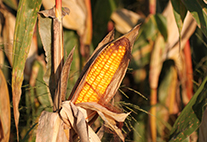Strategy mix can mitigate the climate impacts on EU farmlands
4 October 2016, by Franziska Neigenfind

Photo: Bouda/pixelio
News from Climate Science: Once a month, climate researchers report on their latest findings in the newspaper "Hamburger Abendblatt". The economist Natalie Trapp
Europe’s farmers have already responded to climate change: heat-tolerant plants like soya and maize, which previously thrived further south, are now being grown in Germany. In England grapes are flourishing, while droughts in France and Spain are putting vineyards out of business. To some extent farmers can compensate for the changes in temperature and rainfall, but some regions of southern Europe are expecting significantly reduced harvests. How will this development continue and how can individual businesses adapt?
To answer these questions, I calculated the effects of climate change on agricultural production in the European Union (EU) up to 2100. To do so, I analyzed an extensive EU Commission dataset: about 80,000 agricultural businesses from all member states were surveyed over a 20-year timespan. Every year those surveyed provided information on more than 1000 aspects – for example what and how much they produced, which areas they irrigated, and whether the farmers leased or owned the agricultural land. Information on their age and how they run their business was also collected, since these factors have an effect on how farmers respond to the changes.
First, with the help of a computational model I determined the impact of climate and weather in the past. To do so, I combined the EU dataset with soil and weather data from the different regions for recent decades. I was then able to forecast how climate change will affect farming in the future. I simulated various possible climate developments and calculated the respective consequences for agricultural production.
My results show that adapting rapidly is difficult, since farmers can’t rapidly switch to hardier crops. If greenhouse-gas emissions aren’t dramatically reduced, cereal production in the EU will fall by around 20 percent. While northern Germany and Great Britain could profit from the higher temperatures, the biggest losses are expected in the Mediterranean. If farming methods aren’t modified, the cereal harvest there could drop by more than half.
In the middle term, even greater financial losses are to be expected. Farmers will have to change their production methods or introduce new irrigation systems. However, production often becomes less efficient during adjustment periods. As a result, profits could fall by as much as 17 percent, and in Southern Europe potentially even 84 percent.
And long term? The commercial sector, for example, can reduce the pressure to adjust and the economic consequences of climate change when the regions most affected begin importing more products from those that are less affected. In addition, the model shows that the climate effects can be mitigated by shifting cereal production further north. Farmers can best adapt by combining various strategies and measures – for example by using more fertilizer, practicing crop rotation and expanding the amount of land they farm. Though this will mean investing in both technology and climate-oriented education, only by doing so can they effectively reduce future economic losses.
